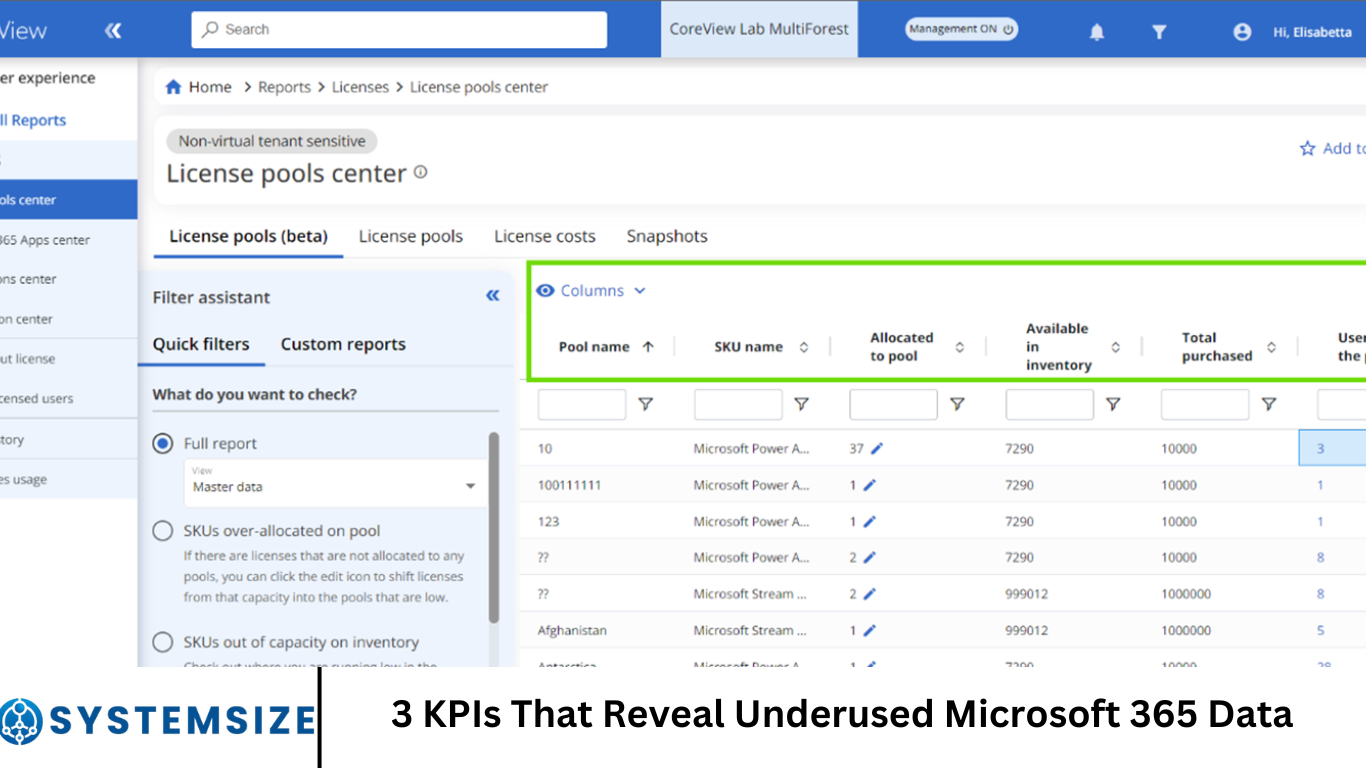As organisations accelerate their digital transformation and shift more workloads to the cloud, platforms like Microsoft 365 have become integral to daily business operations. While Microsoft 365 offers powerful collaboration and productivity tools, many organisations are unaware of the growing volumes of data they store and how much of it remains underused.
In fact, according to a recent study, 53% of EMEA organisations exceeded their cloud storage budgets in 2023, and 91% plan to increase them in 2024. The exponential growth of data not only impacts operational costs but also undermines sustainability efforts.
More Read: Top 11 Data Analytics Tools to Use in 2025
1. File Activity Rate (FAR)
What It Measures: File Activity Rate tracks the frequency of access, modification, or interaction with files stored in Microsoft 365. This includes platforms like OneDrive, SharePoint, and Teams. A low FAR indicates that a large portion of stored files hasn’t been accessed or edited for a considerable amount of time.
Why It Matters: Files that remain untouched for months or years are likely candidates for ROT. Continuously storing these files not only eats up cloud storage space but also complicates data governance. Identifying files with low or no activity enables IT teams to archive, delete, or move them to more cost-effective storage solutions.
How to Use It:
- Use Microsoft 365 compliance tools or third-party solutions to generate file activity reports.
- Set thresholds (e.g., files untouched for 12 months) to flag inactive data.
- Implement workflows to review and dispose of inactive files securely.
Real-World Example: A financial services firm used FAR metrics to identify project files in SharePoint that hadn’t been accessed in over two years. By archiving 40% of their stored documents, they saved $250,000 annually in storage costs and reduced compliance risk.
2. User Engagement Index (UEI)
What It Measures: The User Engagement Index assesses how actively users are engaging with shared content across Microsoft 365 platforms. This KPI combines metrics like document collaboration frequency, comments, versioning activity, and shared access requests.
Why It Matters: Data that is shared but rarely engaged with often signals ROT. A document might be stored and shared with multiple users, but if no one comments, updates, or interacts with it, it may no longer serve its intended purpose. Tracking UEI helps identify such disengaged content.
How to Use It:
- Use Microsoft Viva Insights, Microsoft Graph, or Power BI to monitor engagement trends.
- Correlate engagement data with sharing and permission levels to spot redundant or obsolete content.
- Revoke access to underused shared content and notify content owners for cleanup.
Real-World Example: An international consultancy firm used UEI to discover that 70% of their shared Teams files hadn’t been edited or commented on for over 18 months. This allowed them to decommission old collaboration spaces and reduce storage expenses by 30%.
3. Storage Utilisation Efficiency (SUE)
What It Measures: Storage Utilisation Efficiency evaluates the ratio of actively used storage to total allocated or consumed storage in Microsoft 365. High-efficiency scores indicate that storage is being used productively, while low scores signal that much of the storage is occupied by underused or ROT data.
Why It Matters: SUE offers a high-level view of how effectively your storage investments are being utilised. By identifying low-efficiency departments or business units, IT leaders can target specific areas for data clean-up and user education.
How to Use It:
- Calculate SUE by dividing active file storage (files accessed within a recent timeframe) by total storage used.
- Use tools like the Microsoft 365 Admin Center, PowerShell scripts, or third-party analytics solutions.
- Set department-level benchmarks to encourage better data hygiene practices.
Real-World Example: A multinational retail chain analysed their SUE metrics and found that their marketing department was using 40% of total storage but had only 10% active file access. This led to a comprehensive clean-up initiative that reclaimed over 5 TB of storage and improved system responsiveness.
Benefits of Monitoring These KPIs
Monitoring these KPIs not only helps in identifying underused data but also delivers broader organisational benefits:
- Cost Savings: Reducing unused data directly cuts down on cloud storage expenses.
- Improved Compliance: Helps meet data retention and deletion policies more effectively.
- Enhanced Performance: Streamlined data leads to faster system response and better user experience.
- Sustainability: Reducing data waste supports greener IT practices and corporate ESG goals.
Steps to Take Action
- Audit Your Current Data: Use Microsoft 365 tools to run a comprehensive analysis of your data landscape.
- Define Policies: Establish clear policies around data retention, archiving, and deletion.
- Automate Workflows: Implement automated workflows for flagging and removing ROT data.
- Educate Users: Raise awareness among employees about responsible data management.
- Review Regularly: Make KPI reviews a quarterly or biannual practice to maintain control.
Frequently Asked Question
What is ROT data and why is it important to identify in Microsoft 365?
ROT stands for Redundant, Obsolete, and Trivial data. Identifying ROT in Microsoft 365 is crucial because it helps reduce storage costs, improves system performance, and ensures compliance with data retention policies.
How does the File Activity Rate (FAR) help in identifying underused data?
FAR tracks how often files are accessed or modified. A low FAR indicates that files have not been used for a long period, making them potential candidates for archiving or deletion.
What tools can I use to track these KPIs within Microsoft 365?
Tools such as Microsoft 365 Compliance Center, Microsoft Graph, Microsoft Viva Insights, Power BI, and PowerShell scripts can help monitor file activity, user engagement, and storage utilisation.
What is considered a low User Engagement Index (UEI), and how should I respond?
A low UEI indicates minimal collaboration or interaction with shared files. When engagement is low, consider revoking shared access, notifying owners, and reviewing the data for potential deletion.
How do I calculate Storage Utilisation Efficiency (SUE)?
SUE is calculated by dividing the volume of actively used storage (e.g., files accessed in the past 90 days) by total storage consumed. Low SUE scores suggest inefficient storage use.
Can monitoring these KPIs really save money for large enterprises?
Yes. Many enterprises save hundreds of thousands—sometimes millions—annually by identifying and removing or archiving ROT data. One firm saved $250,000 a year by acting on FAR data alone.
How often should we review these KPIs to maintain data hygiene in Microsoft 365?
It’s recommended to review these KPIs quarterly or biannually. Regular monitoring ensures ongoing optimisation, cost control, and compliance.
Conclusion
Underused and ROT data can quietly erode your organisation’s efficiency, compliance, and bottom line. By focusing on KPIs like File Activity Rate, User Engagement Index, and Storage Utilisation Efficiency, organisations can gain clear visibility into their Microsoft 365 environment and take strategic steps toward optimisation. As the volume of digital data continues to grow, having a proactive data management strategy isn’t just a best practice—it’s a business necessity.


